Understanding Pool Tile and Grout
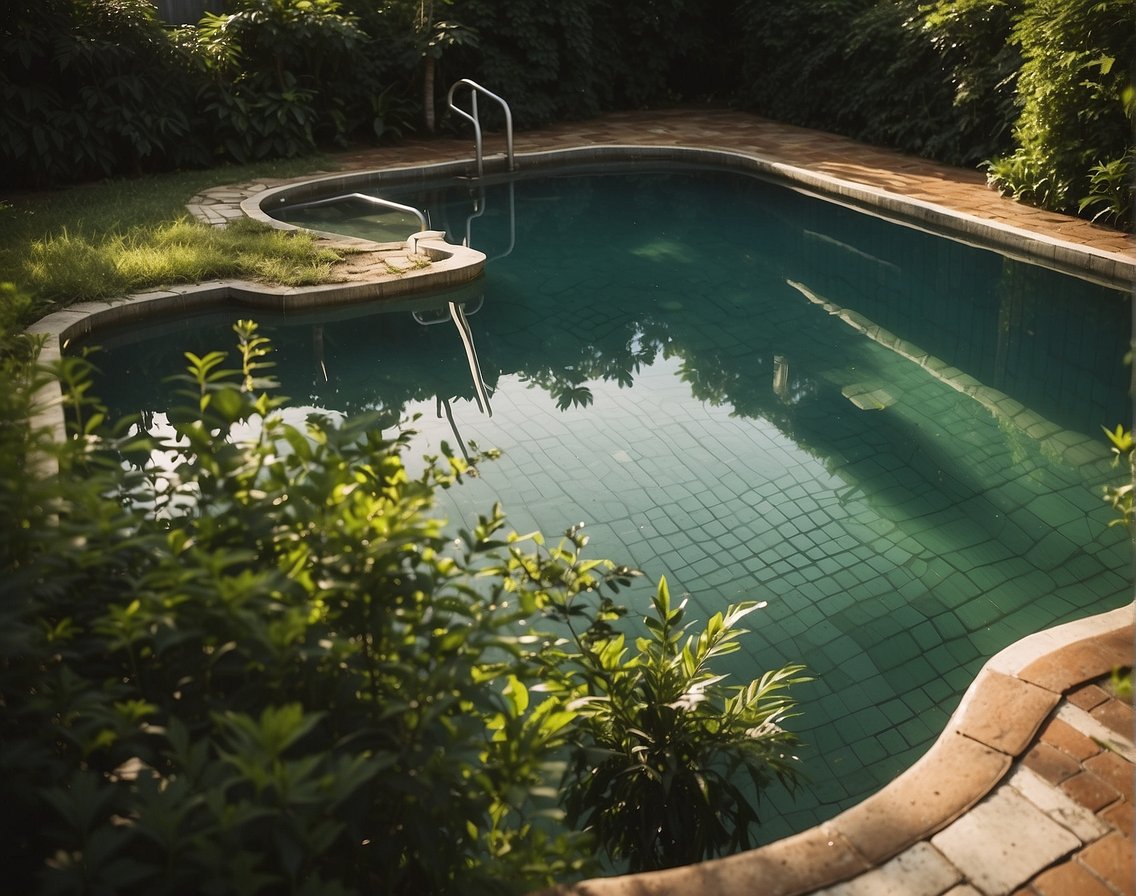
When we maintain swimming pools, a critical aspect often overlooked is the care of the pool’s tile and grout. Pool tile serves not only as a decorative edge but also as a practical feature to keep the pool clean and safe. Unlike tiles used for a bathroom backsplash or kitchen floor, pool tile must withstand constant exposure to water, chemicals, and varying temperatures.
The grout between pool tiles, typically, can be porous, allowing algae and grime to take hold. Over time, this can lead to discoloration and deterioration. Effective grout cleaning and consistent maintenance are key to preserving the beauty and integrity of the pool.
Here’s a brief breakdown of the types of grout commonly used in pool applications:
- Cement Grout: This is a traditional option that’s budget-friendly and relatively easy to apply. Cement grout is porous and may require more frequent cleaning and sealing.
- Epoxy Grout: More resilient than cement, epoxy grout is less porous, offering better resistance to chemicals and staining. It’s often considered the superior choice for pool areas due to its durability.
In addition to regular cleaning, it’s essential for us to seal grout periodically to protect it from moisture and chemicals. The sealing process involves applying a liquid coating that penetrates the grout and forms a protective barrier.
To summarize, the selection of pool tile and grout needs to account for their exposure to harsh pool elements. By choosing the right materials and employing an effective cleaning and maintenance routine, we can ensure that our swimming pools remain both inviting and hygienically safe.
DIY Cleaning Solutions for Effective Maintenance

For pool owners in Georgia, keeping tiles and grout clean is essential for a well-maintained swimming area. We focus on two main types of DIY cleaning solutions: natural and chemical. Each can effectively combat dirt, grime, and stains on pool tiles and grout.
Natural Cleaning Agents
Natural cleaning agents are non-toxic and ideal for regular maintenance to keep tiles free of mold and mildew. Among the most effective natural cleaners are vinegar and baking soda.
- Vinegar and Water Solution: Mix equal parts of white vinegar and water in a spray bottle. This solution is effective in tackling algae and light grime. Spray it onto the tile, let it sit for a few minutes, then scrub gently with a brush and rinse.
- Baking Soda Paste: Create a paste using baking soda (sodium bicarbonate) and a small amount of water. Apply the paste to grout lines for a deeper clean. The natural abrasive nature of baking soda helps in removing tough stains without harming the grout.
Chemical Cleaning Solutions
When natural solutions are not enough, we can turn to chemical cleaners for more thorough cleaning. Always wear gloves and ensure proper ventilation when using these substances.
- Bleach Solution: Dilute bleach with water (1 part bleach to 4 parts water) for an effective stain remover. It also helps eliminate mold and mildew. Apply the solution, let it stand for a short period, and then thoroughly rinse the area with water.
- Oxygen Bleach: Oxygen bleach is safer than standard bleach and is a powerful cleaning agent. Mix the oxygen bleach powder with water following the manufacturer’s instructions. Let the solution sit on the tile and grout for 15 minutes before scrubbing and rinsing.
- Hydrogen Peroxide: Hydrogen peroxide is another alternative for removing dark stains and disinfecting tile surfaces. Apply it directly to the stain, let it bubble for a few minutes, then scrub and rinse.
- Muriatic Acid: For extremely tough stains, muriatic acid can be used cautiously. Dilute it according to the guidelines, apply to the affected area, and rinse thoroughly after a short waiting period. Handle with care, as muriatic acid is highly corrosive.
Step-by-Step Cleaning Procedure
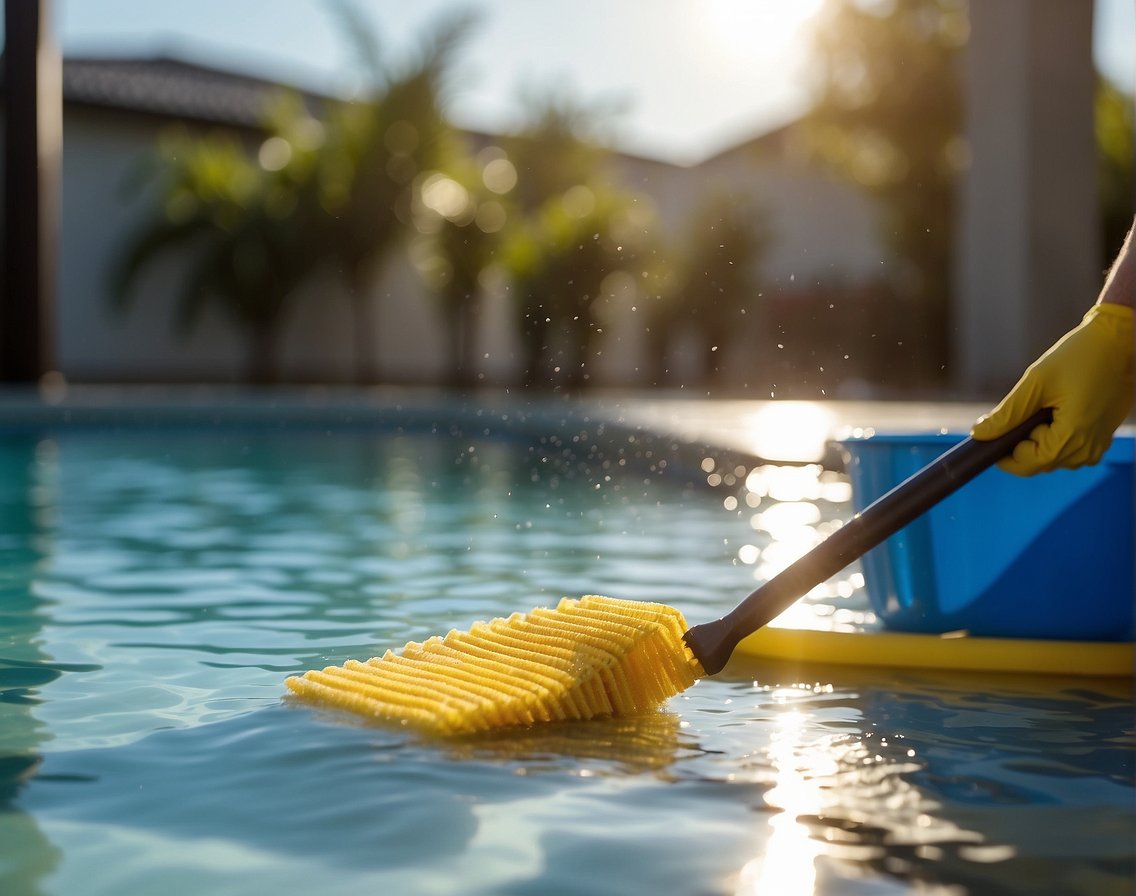
Preparation:
- First, we gather our materials: gloves, safety goggles, a pressure washer or hose, a scrub brush, a sponge, and a toothbrush for tight spaces.
- We ensure the pool area is clear of any debris and personal items.
Initial Rinse:
- We start by giving the tiled area an initial rinse with a hose or pressure washer to remove loose dirt and grime. Warm water is preferred to aid in loosening particles.
Applying the Cleaning Solution:
- For a deep clean, we create a paste using baking soda and hydrogen peroxide, or mix dish soap with warm water for general scrubbing. We spread this paste or solution generously over the tiles and let it sit for several minutes.
Scrubbing:
- We put on our gloves and safety goggles before starting the scrubbing process.
- Using a scrub brush or sponge, we start scrubbing the tiles with moderate pressure. We apply extra elbow grease to areas with more significant staining.
- For smaller or more difficult-to-reach areas, we use a toothbrush for meticulous scrubbing.
Final Rinse:
- Once the scrubbing is done and the dirt is lifted, we rinse off the cleaning solution thoroughly with a hose or pressure washer. This step may need to be repeated to ensure all cleaning agents have been washed away.
Drying:
- We allow the surface to air dry or, if necessary, we use clean towels to dry off excess water to prevent new stains from forming.
By following these steps, we ensure effective tile and grout cleaning for our pool in Georgia, maintaining a pleasant and hygienic recreational environment.
Preventative Measures and Ongoing Care
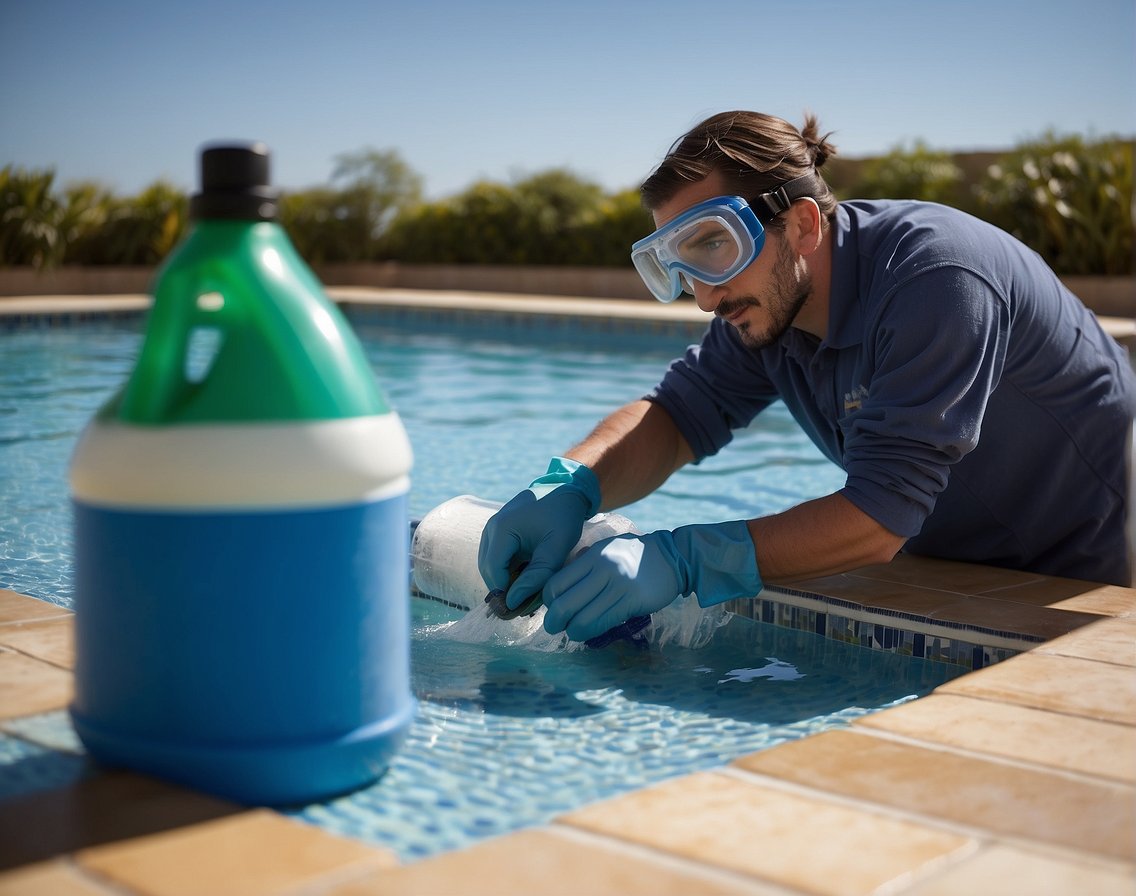
Maintaining a pristine pool area in Georgia is crucial, not only for aesthetics but for cleanliness and durability. Weather in this region can impose harsh conditions, so preventative measures are vital. Here are some steps we can take for effective maintenance:
- Regular Mopping: Using a soft mop weekly to clean the tiles removes dirt and debris, preventing grime buildup.
- Effective Grout Cleaning: We should clean grout lines periodically with a soft brush and gentle cleaner to maintain an inviting appearance.
- Grout Sealing: After a thorough cleaning, apply a grout sealer to repel moisture and prevent mold growth, which can be especially frequent in Georgia’s humid climate.
- Steam Mopping: Consider using a steam mop for deep cleaning sessions, which can be sanitized without harsh chemicals.
- Weather Considerations: In response to harsh weather, ensure pool maintenance includes checking tile and grout for damage, and keeping them sealed and clean.
- Scheduled Cleanliness: Set a routine for both tile and grout cleaning to ensure the pool area remains inviting.
By integrating these ongoing care steps, we ensure the longevity and beauty of our pool spaces. Here is a simple maintenance table:
| Frequency | Task |
|---|---|
| Weekly | – Soft mop pool tiles |
| Monthly | – Deep clean grout |
| Bi-Annually | – Apply grout sealer |
| As Needed | – Check and repair tile after extreme weather |
By diligently following these practices, we not only keep our pool area looking aesthetically pleasing but also contribute to a clean and welcoming outdoor living space.
Safety and Best Practices in Tile and Grout Cleaning
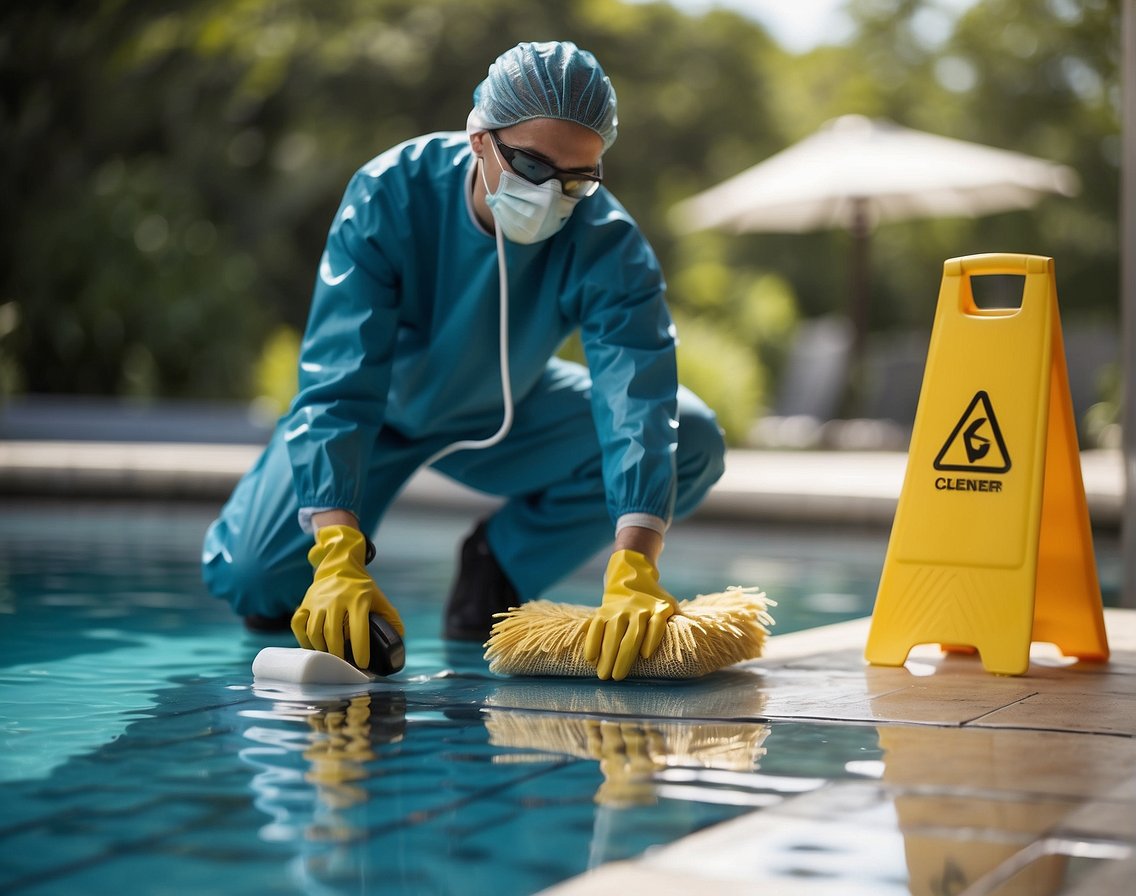
When we tackle DIY tile and grout cleaning, particularly around pools in Georgia, it’s imperative to make safety our top priority. Here are some safety measures and cleaning practices worth noting:
Protective Gear:
- Safety Goggles: To shield our eyes from splashes
- Gloves: Latex or non-latex gloves protect our hands from cleaning solutions; use robust materials for added strength.
Cleaning Know-How:
- Knowledgeable Approach: Understanding the type of tiles and grout we’re dealing with helps us select the proper cleaning methods.
- Test Products: Before applying a cleaner over a large area, we should test it on a small, inconspicuous section for any adverse reactions.
Cleaning Agents:
- pH Balance: We aim for cleaning agents that maintain a neutral pH balance to preserve the stain resistance of our grout without compromising its integrity.
- Avoid High Alkalinity: Solutions with high alkalinity levels might damage tile surfaces; therefore, we adhere to using milder cleaners.
Best Practices:
- Sweep the area to remove debris.
- Wet the surface slightly before applying cleaners to prevent rapid evaporation.
- Respect the contact time recommended for cleaners to ensure effectiveness.
- Avoid abrasive tools that can scratch tiles or wear down grout.
By adhering to these safety guidelines and cleaning techniques, we can maintain a pristine and safe pool area. Regular, safe cleaning extends the life of our pool surfaces and keeps our leisure spaces inviting and hygienic.
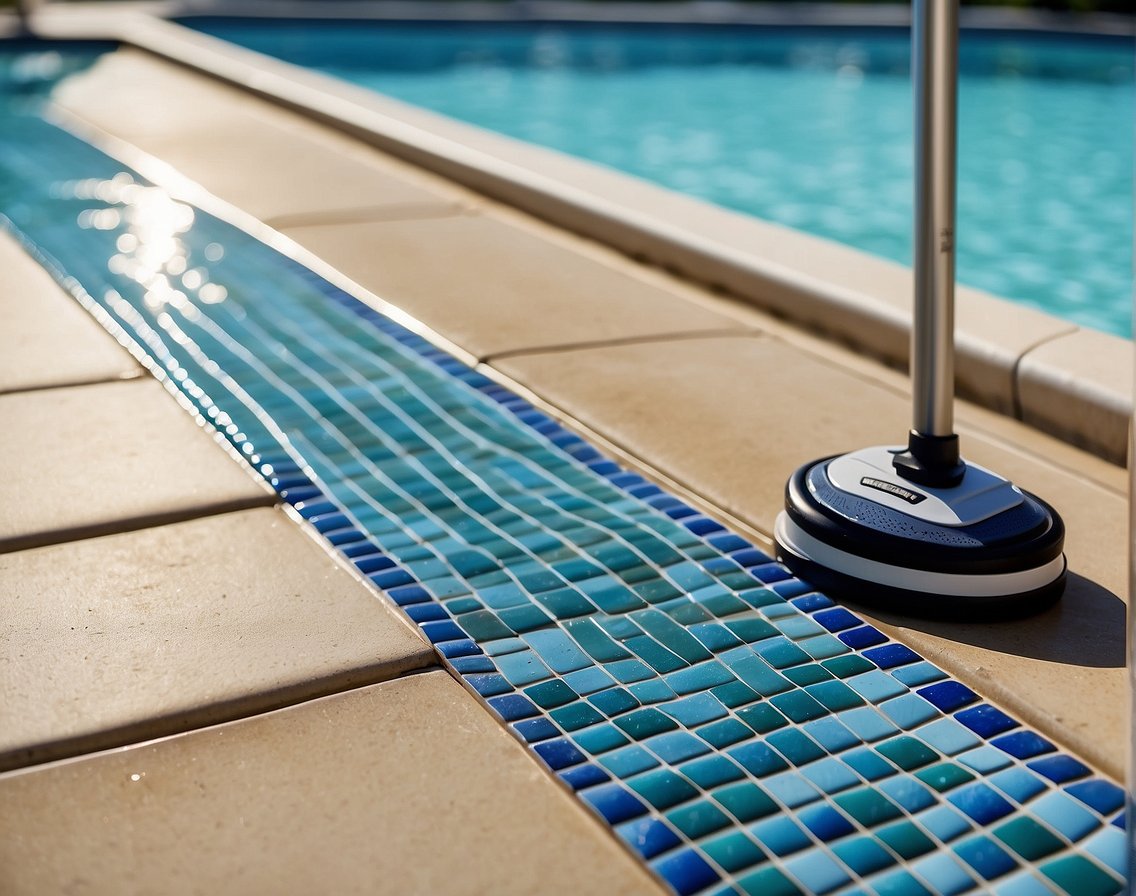
Frequently Asked Questions
As pool owners in Georgia, we must address the challenges of keeping our pool tiles and grout clean. Safety, effectiveness, and proper maintenance are key to our DIY approach. Let’s answer some common questions on the subject.
What is the safest method for cleaning grout in pool areas?
For cleaning grout safely, we recommend using a mixture of baking soda and vinegar. Apply the paste to the grout, let it sit for a few minutes, and then scrub gently with a brush. This method avoids harsh chemicals and is safe for most pool surfaces.
Can muriatic acid be safely used for cleaning pool tiles without damaging them?
Yes, muriatic acid can be used carefully and in diluted form. It’s important to use personal protective equipment and follow the manufacturer’s dilution instructions precisely to prevent damage to the tiles and ensure your safety.
How can I effectively remove calcium deposits from my pool tiles?
Removing calcium deposits effectively can be done with a pumice stone or a commercial calcium remover. When using a pumice stone, use gentle, circular motions to avoid scratching the tiles. Commercial removers should be applied according to the manufacturer’s guidelines.
What are the risks of using muriatic acid for tile cleaning and how can I mitigate them?
The risks of using muriatic acid include damage to pool surfaces, harm to landscaping, and personal injury due to its highly corrosive nature. To mitigate these risks, always dilute the acid properly, use protective gear, and rinse treated areas thoroughly after application.
Are there any professional-grade substances suitable for DIY grout and tile cleaning in pools?
Professional-grade substances like phosphoric acid cleaners can be suitable for DIY projects, as they are less aggressive than muriatic acid. Always follow the instructions on the label and ensure adequate ventilation when using these products.
What steps should I follow to properly maintain clean tiles and grout in my swimming pool?
To properly maintain clean tiles and grout, we advise following a regular cleaning schedule, using gentle, non-abrasive cleaners, and periodically inspecting the pool for signs of mold, mildew, and algae. Regular maintenance avoids the build-up of tough stains and extends the life of your pool surfaces.
